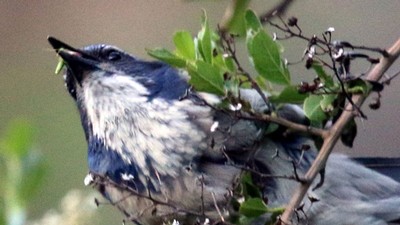With thousands of other scholars, Utah State University physicists Josh Hodges and J.R. Dennison headed to Florida for spring break. But Hodges and Dennison didn’t spend their time partying on the beach. Instead, the two scientists watched the Shuttle Endeavor, carrying an experiment on which they’ve labored over the past two years, blast into space during the early morning hours of March 11.
“It was an amazing experience that will forever be engraved in my mind,” says Hodges, a graduate student and research technician in professor Dennison’s Surface Physics Lab. “The peaceful night was broken by an early sunrise and my pant legs started flapping in the wind as the shuttle disappeared into the low-lying clouds. Wow, what a rush.”
The USU experiment, called ‘SUSpECS’ for “State of Utah Space Environment and Contamination Study,” consists of four panels — about the size of graham crackers, Hodges says — containing about 168 material samples. SUSpECS is part of a larger NASA study called MISSE, short for Materials International Space Station Experiment, aimed at finding materials suitable for crafting future space vehicles and instruments.
“We’re testing a variety of insulating materials, including plastics, carbon and fiberglass composites, gold, silver, copper, quartz and a combination of these,” says Hodges, who graduated from USU in 2006 with a bachelor’s degree in mechanical engineering. “Shuttle astronauts will actually attach our experiment to the outside of the International Space Station.”
Two panels from USU’s experiment will be attached to the ‘ram’ side of the space station, Hodges says, where they’ll experience the full brunt of space’s punishing environment, including atomic oxygen and charged particles in solar wind. Astronauts will attach a third set to the ‘wake’ or rear side of the station, which exposes samples to ultraviolet light. The fourth panel, a control, will also be attached to the station’s surface but will be shielded from the environment.
The USU panels will stay on the space station until they’re retrieved by shuttle astronauts during a future shuttle mission, expected in nine to 12 months, and returned to Utah State.
Having the opportunity to study samples that have flown in space is “really unique” says Dennison, faculty member in the College of Science’s Physics Department. “With most space experiments you never get to see them again.”
Examination of the travel-worn samples will yield valuable information about how various materials hold up in space — information that NASA seeks as it develops the James Webb Space Telescope, the Solar Probe and instruments planned for future lunar and Mars missions.
“In addition, we want to find out if the calculations we’re conducting with our equipment here at USU to test spacebound materials are accurately mimicking the space environment,” Hodges says.
Boeing, prime contractor on the NASA and U.S. Air Force-funded MISSE experiment, contacted Dennison for help in developing the SUSpECTS project in 2005. “It took him about two seconds to say ‘yes.’” Hodges says.
During their Florida visit, Hodges and Dennison received an L-1 — one day to launch — tour of the Kennedy Space Center at Cape Canaveral and were introduced to former shuttle astronauts. The Aggies were invited to watch the launch from an official site three miles from the launch pad; two miles closer than the public viewing area.
Related links:







